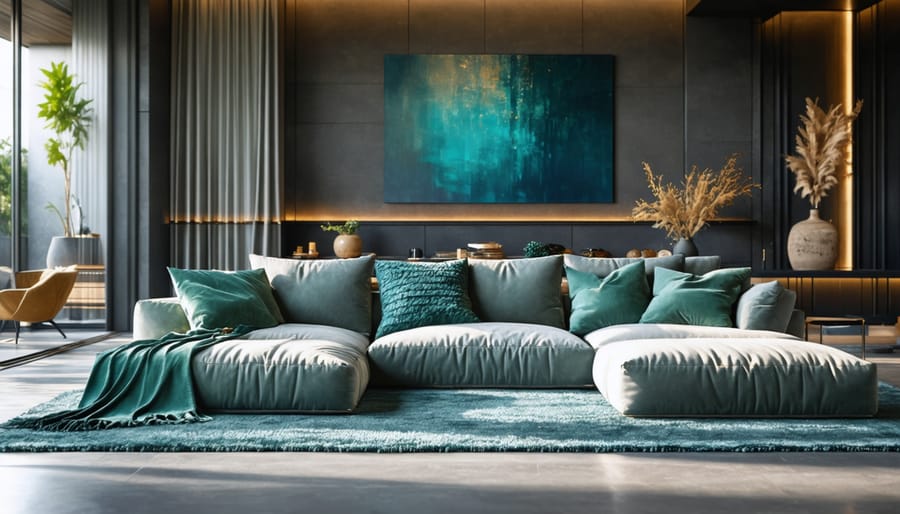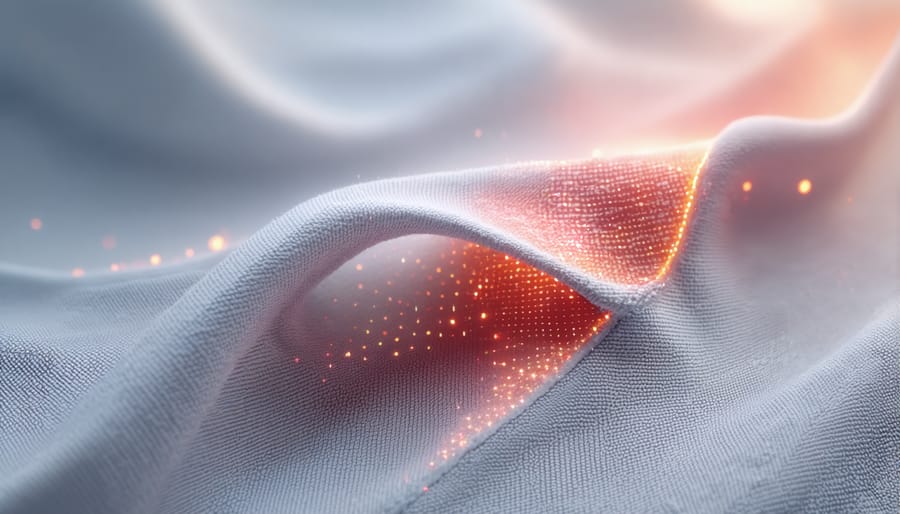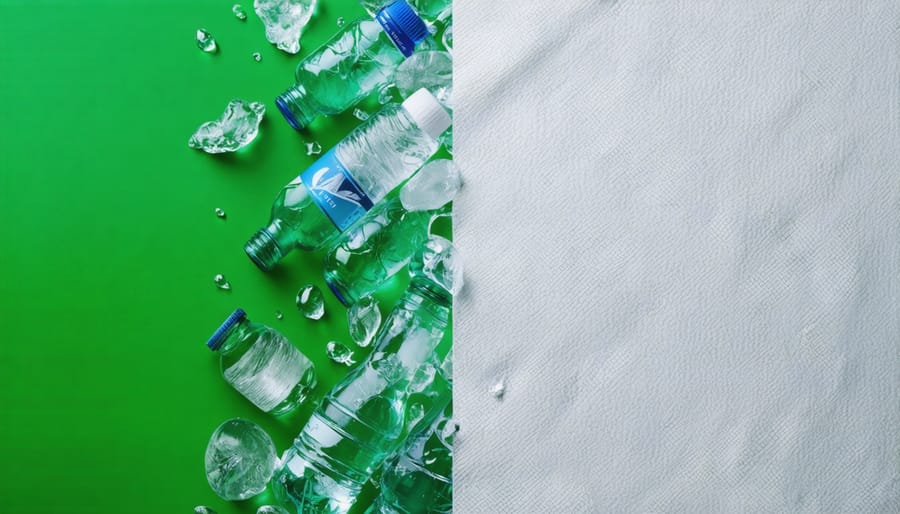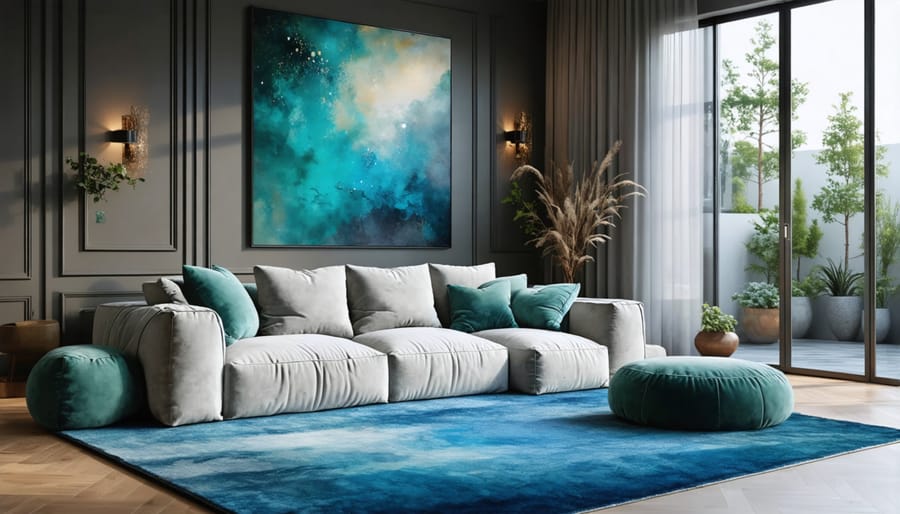
The evolution of textile innovation is revolutionizing interior design, merging cutting-edge technology with timeless comfort. From self-cleaning fabrics that repel stains to smart textiles that actively regulate room temperature, today’s advanced materials are transforming how we experience and interact with our living spaces. These breakthrough developments aren’t just about aesthetics—they’re creating healthier, more sustainable, and increasingly functional environments for both residential and commercial properties.
Modern textile innovations address the growing demands for sustainability, durability, and multi-functionality in interior design. Antimicrobial fabrics protect against bacteria while maintaining their visual appeal, while moisture-wicking materials enhance comfort in high-traffic areas. Performance textiles now combine the sophistication of luxury materials with practical features like UV resistance and easy maintenance, making them ideal for both elegant homes and busy commercial spaces.
This fusion of technology and textile craftsmanship opens new possibilities for interior designers and property managers seeking to create spaces that are both beautiful and intelligently functional.
Temperature-regulating fabrics represent a significant advancement in interior comfort and energy efficiency. These innovative textiles incorporate phase-change materials (PCMs) that actively respond to temperature fluctuations, making them ideal for both upholstery and window treatments. When integrated with smart home integration, these fabrics can help maintain optimal room temperatures while reducing energy costs.
The science behind PCMs is remarkably practical: tiny capsules within the fabric absorb excess heat when temperatures rise and release it when the environment cools. This creates a natural temperature-buffering effect that can help maintain comfort levels throughout your space. In upholstery applications, these materials can make leather and fabric furniture more comfortable year-round, preventing that uncomfortable sticky feeling in summer or cold shock in winter.
For window treatments, temperature-regulating fabrics offer dual benefits: they help maintain consistent room temperatures while protecting your furniture from harmful UV rays. This innovative technology not only enhances comfort but also contributes to the longevity of your interior furnishings, making it a smart investment for both residential and commercial spaces.

Nanotechnology has revolutionized fabric protection, introducing a new generation of self-cleaning and stain-resistant materials that make maintenance easier than ever. These innovative textiles utilize microscopic structures that repel liquids, dirt, and stains, creating a protective barrier that keeps furniture looking fresh for longer.
The science behind these materials involves applying nano-sized particles to fabric fibers, creating a surface tension that causes liquids to bead up and roll off instead of being absorbed. This technology mimics nature’s own solutions, such as the lotus leaf effect, where water droplets simply pearl away, taking dirt particles with them.
For homeowners and property managers, these advanced textiles offer practical benefits beyond just stain resistance. They reduce the need for chemical cleaners, require less frequent professional cleaning, and maintain their appearance even in high-traffic areas. Some varieties even incorporate antimicrobial properties, helping to keep furniture hygienic and fresh.
Recent developments have made these technologies more durable and environmentally friendly, withstanding multiple washes while maintaining their protective qualities. This advancement represents a significant step forward in combining functionality with sustainability in modern textile design.
In recent years, the interior design industry has embraced sustainable material choices through innovative recycled and upcycled fabrics. Leading manufacturers are transforming post-consumer plastic bottles into luxurious performance velvet, offering both elegance and durability for high-traffic areas. These materials are particularly popular in commercial spaces, where they provide the look of premium textiles while maintaining exceptional wear resistance.
Another breakthrough comes from recycled cotton and wool fibers, which are being reimagined into sophisticated upholstery materials. These fabrics retain the natural beauty and texture of virgin materials while significantly reducing environmental impact. Designer collections now feature denim-inspired textures created from recycled jeans, and maritime rope waste is being transformed into striking decorative textiles.
What’s particularly exciting is how these materials are performing in real-world applications. Hotels and restaurants report that recycled polyester blends are outperforming traditional fabrics in terms of stain resistance and color retention, while recycled wool varieties offer superior flame-retardant properties naturally. These innovations prove that choosing eco-friendly materials no longer means compromising on style or functionality.

Nature continues to inspire groundbreaking solutions in textile innovation through bio-based materials. These sustainable alternatives combine environmental responsibility with exceptional performance characteristics. Manufacturers are now creating fabrics from sources like pineapple leaves, mushroom mycelium, and recycled coffee grounds, offering unique textures and properties that rival traditional materials.
For example, fabrics derived from bamboo fibers provide natural antimicrobial properties and exceptional breathability, making them ideal for upholstery in high-traffic areas. Cork-based textiles offer water-resistant qualities while maintaining a luxurious feel, perfect for both residential and commercial applications.
The rise of plant-based leather alternatives has revolutionized furniture restoration, providing durable, eco-friendly options that maintain the sophisticated appearance of traditional leather. These materials often require less maintenance and show remarkable resistance to wear and tear.
What makes these bio-based solutions particularly appealing is their ability to combine sustainability with practical benefits. They often feature natural stain resistance, improved durability, and enhanced comfort, all while reducing environmental impact. This makes them an increasingly popular choice for conscious consumers seeking both style and sustainability in their interior spaces.
Modern textile innovations have revolutionized the way we approach both durability and aesthetic appeal in interior design. Advanced fiber technologies now allow fabrics to resist stains, repel water, and maintain their original appearance far longer than traditional materials. These performance textiles incorporate nano-coating treatments that create an invisible barrier against spills and dirt while preserving the fabric’s natural texture and breathability.
One of the most exciting developments is the emergence of self-cleaning fabrics that use photocatalytic properties to break down organic matter when exposed to light. This technology is particularly valuable in high-traffic areas where maintaining pristine upholstery can be challenging. Similarly, antimicrobial treatments have become standard in commercial and residential textiles, offering protection against bacteria and extending the life of furniture pieces.
Design innovation hasn’t taken a backseat to functionality. Today’s engineered fabrics offer unprecedented opportunities to blend traditional with modern design through textiles that mimic natural materials while offering superior performance. Digital printing techniques allow for intricate patterns and vibrant colors that maintain their intensity even after years of use, while new weaving technologies create textures that were previously impossible to achieve.
These advancements mean that homeowners no longer need to choose between beauty and practicality – they can have both in a single textile solution that enhances their living spaces while standing up to daily wear and tear.
Modern textile innovation has revolutionized the way we approach color and texture in fabrics. Advanced dyeing techniques now allow for photochromic and thermochromic effects, creating fabrics that change color in response to light or temperature. These smart textiles offer exciting possibilities for both aesthetic appeal and practical applications in furniture and interior design.
Nanotechnology has enabled the development of fabrics with unprecedented texture control. Manufacturers can now create surfaces that are ultra-soft, self-cleaning, or uniquely textured at the microscopic level. These innovations have made it possible to produce fabrics that maintain their appearance longer while offering enhanced comfort and functionality.
Digital printing technologies have transformed fabric customization, allowing for intricate patterns and photo-realistic designs that were previously impossible to achieve. This technology enables designers to create bespoke furniture pieces with precise color matching and complex designs that perfectly complement existing décor schemes.
Recent developments in biomimetic textures have led to fabrics that replicate natural surfaces, from the softness of rose petals to the water-repellent properties of lotus leaves. These nature-inspired innovations not only enhance the tactile experience but also contribute to the fabric’s durability and maintenance properties.
Eco-friendly dyeing processes using plant-based pigments and low-water techniques are gaining prominence, offering sustainable alternatives without compromising on color vibrancy or fastness. These methods produce unique color variations that add character to furniture pieces while reducing environmental impact.

The future of interior design is being radically transformed by textile innovations, creating spaces that are not just visually appealing but also smarter, more sustainable, and highly functional. As we’ve explored throughout this article, advanced fabrics are revolutionizing how we interact with our living and working environments. From self-cleaning textiles that reduce maintenance needs to temperature-regulating materials that enhance comfort while reducing energy costs, these innovations are proving to be game-changers in modern interior design.
Looking ahead, we can expect to see even more integration of smart textiles with IoT technology, creating truly responsive environments that adapt to occupants’ needs. Sustainable innovations will continue to gain prominence, with bio-fabricated materials and recycled textiles becoming mainstream options for environmentally conscious designers and homeowners. The growing emphasis on wellness in interior spaces will likely drive the development of more antimicrobial and air-purifying fabrics.
For property owners and managers, these advancements offer exciting opportunities to enhance the value and functionality of their spaces while potentially reducing long-term maintenance costs. As textile technology continues to evolve, we’ll see more solutions that combine aesthetics with practical benefits, making our interior spaces more comfortable, efficient, and sustainable than ever before. The key to success will lie in choosing the right innovations that align with specific needs while considering long-term durability and maintenance requirements.